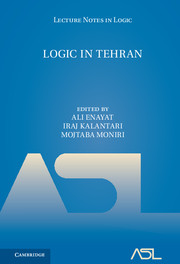Book contents
- Frontmatter
- Contents
- Preface
- Workshop and conference on logic, algebra, and arithmetic: Tehran, October 18–22, 2003
- Foreword
- Mathematical logic in Iran: A perspective
- Real closed fields and IP-sensitivity
- Categoricity and quantifier elimination for intuitionistic theories
- Primes and irreducibles in truncation integer parts of real closed fields
- On explicit definability in arithmetic
- From bounded arithmetic to second order arithmetic via automorphisms
- Local-global principles and approximation theorems
- Beatty sequences and the arithmetical hierarchy
- Specker's theorem, cluster points, and computable quantum functions
- Additive polynomials and their role in the model theory of valued fields
- Dense subfields of henselian fields, and integer parts
- A recursive nonstandard model for open induction with GCD property and cofinal primes
- Model theory of bounded arithmetic with applications to independence results
- Ibn-Sina's anticipation of the formulas of Buridan and Barcan
- Remarks on algebraic D-varieties and the model theory of differential fields
- A simple positive Robinson theory with LSTP ≠ STP
- Categories of theories and interpretations
- References
On explicit definability in arithmetic
Published online by Cambridge University Press: 30 March 2017
- Frontmatter
- Contents
- Preface
- Workshop and conference on logic, algebra, and arithmetic: Tehran, October 18–22, 2003
- Foreword
- Mathematical logic in Iran: A perspective
- Real closed fields and IP-sensitivity
- Categoricity and quantifier elimination for intuitionistic theories
- Primes and irreducibles in truncation integer parts of real closed fields
- On explicit definability in arithmetic
- From bounded arithmetic to second order arithmetic via automorphisms
- Local-global principles and approximation theorems
- Beatty sequences and the arithmetical hierarchy
- Specker's theorem, cluster points, and computable quantum functions
- Additive polynomials and their role in the model theory of valued fields
- Dense subfields of henselian fields, and integer parts
- A recursive nonstandard model for open induction with GCD property and cofinal primes
- Model theory of bounded arithmetic with applications to independence results
- Ibn-Sina's anticipation of the formulas of Buridan and Barcan
- Remarks on algebraic D-varieties and the model theory of differential fields
- A simple positive Robinson theory with LSTP ≠ STP
- Categories of theories and interpretations
- References
Summary
Abstract.We characterize the arithmetic functions in one variable that are explicitly definable from the familiar arithmetic operations. This characterization is deduced from algebraic properties of some non-standard rings of integers. Elementary model theory is also used to show that the greatest common divisor function and related functions are not explicitly definable from the usual arithmetic operations. It turns out that explicit definability is equivalent to computability with bounded complexity, for the recursive algorithms of Y. Moschovakis and with respect to a certain natural cost function.
Introduction.
Motivating Question:Which functions are explicitly definable in the arithmetic Structures
Here iq (“integer quotient”) and rem (“remainder”) describe
integer division with remainder,
that is, iq : and rem : are the functions such that for all we have, with.
We nowspecifywhatwe mean by explicitly definable. Let be an L-structure with distinct marked elements 0,. A function is said to be explicitly definable in M if there are L-terms t1(x), …, tn(x) with x = (x1, …, xm), such that each set
is definable inMby a quantifier-free L-formula, and these sets together cover Mm. (Throughout this paper, m and n range over
An n-ary relation is said to be explicitly definable in M if its characteristic function is explicitly definable inM.
Remarks on explicit definability.
(1) Connection to computation: The recursive programs on M from [7, 8] have the property that explicit definability in M is equivalent to computability by a recursive program on M in a uniformly bounded number of steps, as measured by a certain cost function. A precise statement to this effect can be found in [8].
- Type
- Chapter
- Information
- Logic in Tehran , pp. 65 - 86Publisher: Cambridge University PressPrint publication year: 2006

